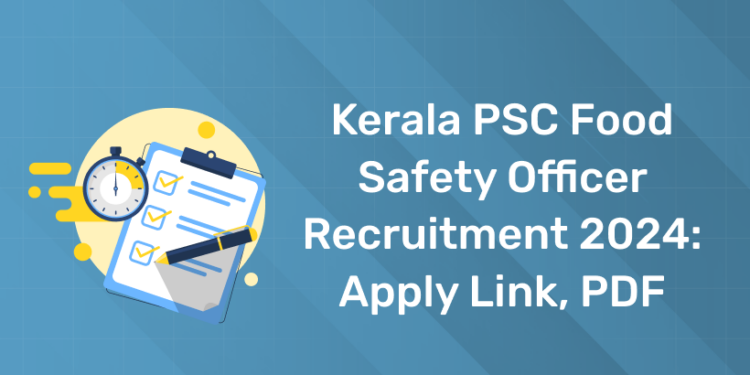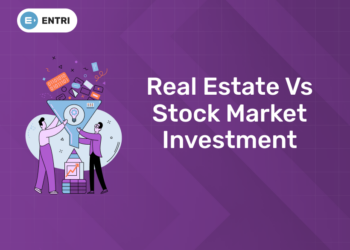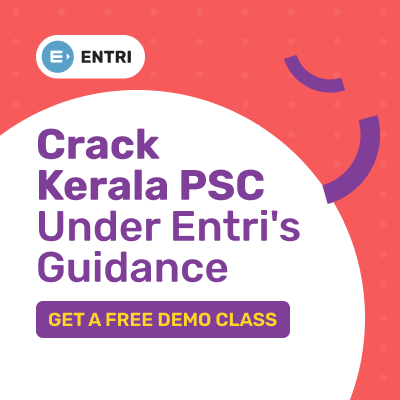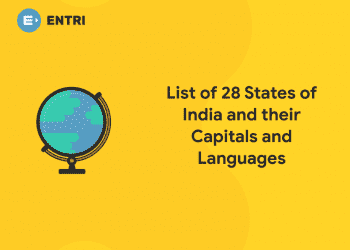Table of Contents
The Kerala Public Service Commission released an official notification regarding Kerala PSC Food Safety Officer Recruitment 2024, Category Number 06/2024, on March 01, 2024. The commission is inviting applications from qualified and eligible candidates for this post. The application link is available on the Kerala PSC website. Eligible candidates can apply from March 01, 2024, till April 03, 2024. To apply for this position, candidates must first complete the ‘ONE TIME REGISTRATION’ process on the official website of the Kerala Public Service Commission. After successful registration, candidates can submit their applications online. Read on for detailed updates!
Kerala PSC Food Safety Officer (FSO)(006/2024) Notification 2024 Highlights
| Particulars | Details |
| Name of the Department | Food Safety |
| Name of post | Food Safety Officer |
| Category Number | 006/2024 |
| Notification Date | March 01, 2024 |
| Last Date for Application | April 03, 2024 |
| Method of appointment | Direct recruitment |
| Age limit | 18 to 36 years |
| Scale of pay | Rs 39300 – Rs 83000 |
| Mode of application | Online |
| Number of vacancies | Anticipatory |
| Official website | https://www.keralapsc.gov.in |
Kerala PSC Food Safety Officer Previous Year Question Paper with Answer Key
Click here to download Kerala PSC Food Safety Officer Previous Year question paper free pdf:
FSO Answer Key
DAILY CURRENT AFFAIRS – FREE PDF
Kerala PSC Food Safety Officer 2024 Apply Online
The Kerala Public Service Commission (KPSC) has started accepting applications for the FSO (Food Safety Officer) recruitment in 2024. The KPSC is looking to recruit qualified candidates for the post of Food Safety Officer in different government departments and agencies across Kerala.
The application process started on March 04, 2024, and will run until April 04, 2024. Eligible candidates interested in applying for the post can apply via the PSC Thulasi portal. To apply, candidates will need to log in to the portal using their login credentials. Candidates should fill out the application form with the required details and upload the necessary documents.
The KPSC will shortlist candidates for the FSO recruitment 2024 based on their qualifications and performance in the written test and interview. Successful candidates will be posted in different government departments and agencies across Kerala as per their merit and preference. If you have any questions or concerns about the FSO recruitment 2024, you may contact the KPSC helpdesk, which is available on the PSC Thulasi portal.
Kerala PSC FSO Notification 2024
The official notification of Kerala PSC FSO Recruitment 2024″ was released by the Kerala Public Service Commission (KPSC) on March 01, 2024. The notification provides information on the recruitment process, such as eligibility criteria, application procedure, date of application, selection process, and more. Candidates interested in pursuing a career as an FSO in Kerala should check for the notification and prepare accordingly. The recruitment is conducted for graduates across the state. If you are interested in applying, please check the eligibility conditions and further requirements.
Kerala PSC Food Safety Officer Notification 2024 PDF
The Kerala PSC Food and Safety Officer Notification 2024 is available on the PSC website. The notification PDF is an important document that outlines the details and requirements of FSC Recruitment 2024. It provides candidates aspiring to apply for the Kerala PSC FSO vacancies must carefully read and understand the content of the FSO Notification PDF to ensure they all meet the requirements and adhere to the guidelines laid out by the Kerala Public Service Commission.
Click on the provided link below to download Kerala PSC Food Safety Officer (006/2024) Notification PDF 2024
Kerala PSC Food Safety Officer Notification 2024 – Important Dates
Candidates interested in applying for Kerala PSC Food Safety Officer Vacancy 2024 should keep in mind the important dates for the selection process listed below:
| Event | Date |
| Commencement of online application | March 01, 2024 |
| Last date for online application | April 03, 2024 |
| Exam date | Yet to be announced |
| Result declaration | Yet to be announced |
Ace your preparation for Kpsc Food Safety officer Exam! Get Free Demo Here!
Kerala PSC Food Safety Officer Eligibility Criteria 2024
Candidates who are applying for the FSO Recruitment 2024 should check the eligibility criteria before applying.
Educational Qualification
- Candidates should have a Degree in Food Technology or Dairy Technology or Biotechnology or Oil Technology or Agricultural Science or Veterinary Sciences or Biochemistry or Microbiology or Masters Degree in Chemistry or Degree in Medicine from a University recognised by any of the Universities in Kerala, or its equivalent qualifications.
- Candidates who claim equivalent qualification instead of qualification mentioned in the Notification shall produce the relevant Government order to prove the equivalency at the time of verification, then only such qualification shall be treated as equivalent to the prescribed qualification concerned.
- In the case of difference in original caste/ community claimed in the application and that entered in SSLC book, the candidates shall produce a Gazette notification in this regard, along with Non Creamy Layer Certificate/Community Certificate at the time of certificate verification.
Age Limit
- 18-36 Years
- Only candidates born between 02.01.1988 and 01.01.2006 (both dates included) are eligible to apply for this post. Other backward Communities and SC/ST candidates are eligible for usual age relaxation
Kerala PSC Food Safety Officer Vacancy 2024
Kerala PSC Food Safety Department has announced the vacancies for the post of Food Safety Officer in the Food Safety Department. The vacancies are anticipatory.
| Kerala PSC FSO Vacancy 2024 | |
| Thiruvananthapuram |
Anticipated Vacancy
|
| Kollam | |
| Pathanamthitta | |
| Alappuzha | |
| Kottayam | |
| Idukki | |
| Ernakulam | |
| Thrissur | |
| Palakkad | |
| Malappuram | |
| Kozhikode | |
| Wayanad | |
| Kannur | |
| Kasargod | |
Kerala PSC Food Safety Officer Selection Process 2024
Selection for the position of Kerala PSC FSO Recruitment 2024 will be made based on a competitive test of degree standards. Previously, the FSO selection was conducted through the following rounds;
- Written/OMR Test
- Document Verification
- Interview (If Required)
Training
- The Selected candidates will have to undergo training successfully as specified by the Food Authority in a recognised Institute or Institution approved for the purpose during the period of probation.
Probation
Every person appointed to the post shall from the date on which he joins duty be on probation for a period of two years on duty within a continuous period of three years.
Kerala PSC FSO Application Process 2024: Mode of Apply
Direct Recruitment: The Kerala PSC FSO position is open for applications through a direct recruiting procedure. Please submit your application through the Kerala PSC website. Send in your application as soon as possible, or by the notification date. It should be noted that applications are welcome from all qualified individuals.
How to Submit Kerala PSC FSO Application 2024?
- All candidates must register as per the “ONE TIME REGISTRATION” system on the official website of Kerala Public Service Commission -‘www.keralapsc.gov.in’.
- Candidates who have registered can apply by logging on to their profile using their User ID and password.
- Candidates must click on the ‘Notification’ bar to proceed
- Click on the “Statewide – Direct – General” link.
- Find the Food Safety Officer notification link to apply for the post.
- Click on the ‘Apply Now’ button to apply.
- Enter the Name of the candidate and the date of taking the photograph, available on the photograph in the required field.
- Fill out the application form and tab on Proceed and proceed to verify.
- After reviewing the application form click on the Proceed and Submit tab.
Application Fee
The aspirants of the Kerala PSC FSO recruitment 2024 should note that there is no application fee required to be submitted along with the application form as per last recruitment pattern.
Documents Required
- Certificates to prove Educational qualification
- Experience certificate (If required)
- Certificates as proof of age
- Caste Certificate (if required)
- If the caste of the candidates is wrongly mentioned in their SSLC book, they should claim their original caste in their application and should produce Community/NCLC certificate issued from concerned revenue authority and the gazette notification for the same at the time of certificate
verification - Personal ID card – Aadhar card, PAN card, Driving license( any one)
Advice for beginners when uploading photos
- The photo to be uploaded can be in Color/ black and white.
- The face and shoulder of the candidate should be clearly visible
- Photo should be of 200 pixels height and 150 pixels width
- The file size should not exceed 30kb and it should be in JPG format
- The background of the photo should be either light-colored or white in color
- The eyes should be open
- Face should be centrally focused
- Photograph wearing cap goggles, (except cap, veil worn in adherence to religious custom), photographs showing a portion of the face, photo with unclear face shall not be accepted.
Kerala PSC FSO Application 2024 Guidelines
- Candidates who have AADHAAR Card should add AADHAAR as ID Proof in their profile
- If written/OMR/Online Test is conducted as part of this selection, candidates shall submit a confirmation for writing the examination through their One Time Registration Profile.
- Such candidates alone can generate and download the Admission Tickets in the last 15 days till the date of Test.
- The applications of candidates who do not submit confirmation within the stipulated period, will be rejected absolutely.
- Appropriate disciplinary action as per Rule 22 of the Kerala Public Service Commission Rules of Procedure shall be initiated against those candidates who submit applications with bogus claims of qualification regarding education, experience etc. and are liable to be disqualified for being considered for a particular post or debarment from applying to the Commission either permanently or for any period or the invalidation of their answer scripts or products in a written/practical test or the initiation of criminal or other proceedings against them or their removal or dismissal from office or the ordering of any other disciplinary action against them if they have already been appointed, or any one or more of the above.
Crack KPSC Food Safety exam with Expert Mentors! Get Free Demo Here!
Kerala PSC Food Safety Officer Application 2024: Direct Link, Form
The direct link to apply for the Kerala PSC Food Safety Officer post is given below. The application window will deactivate on April 04, 2024. Interested candidates should apply before mentioned deadline.
Kerala PSC Food Safety Officer Salary 2024
The salary of Food Safety Officer will be in the range Rs. 39,300/- to Rs. 83,000/-
Kerala PSC Food Safety Officer Syllabus (Previous)
Click on the below link to download Kerala PSC FSO previous Syllabus
Kerala PSC FSO Notification 2024 FAQs
1. How can I apply for the Kerala PSC FSO recruitment 2024?
Ans: Candidates can apply for the Kerala PSC FSO recruitment through the official Kerala PSC website.
- All candidates must register as per the “ONE TIME REGISTRATION” system on the official website of Kerala Public Service Commission -‘www.keralapsc.gov.in’.
- Candidates who have registered can apply by logging on to their profile using their User ID and password.
- Candidates must click on the ‘Notification’ bar to proceed
- Click on the “Statewide – Direct – General” link.
- Find the Food Safety Officer notification link to apply for the post.
- Click on the ‘Apply Now’ button to apply.
- Enter the Name of the candidate and the date of taking the photograph, available on the photograph in the required field.
- Fill out the application form and tab on Proceed and proceed to verify.
- After reviewing the application form click on the Proceed and Submit tab.
2. What is the selection process for the Kerala PSC FSO recruitment?
Ans: Age limit for Kerala PSC FSO exam 2024 recruitment:
- 18-36 Years
- Only candidates born between 02.01.1988 and 01.01.2006 (both dates included) are eligible to apply for this post. Other backward Communities and SC/ST candidates are eligible for usual age relaxation
Ans: Educational qualification required for applying for Kerala PSC FSO recruitment 2024 are:
- Candidates should have a Degree in Food Technology or Dairy Technology or Biotechnology or Oil Technology or Agricultural Science or Veterinary Sciences or Biochemistry or Microbiology or Masters Degree in Chemistry or Degree in Medicine from a University recognised by any of the Universities in Kerala, or its equivalent qualifications.
- Candidates who claim equivalent qualification instead of qualification mentioned in the Notification shall produce the relevant Government order to prove the equivalency at the time of verification, then only such qualification shall be treated as equivalent to the prescribed qualification concerned.
- In the case of difference in original caste/ community claimed in the application and that entered in SSLC book, the candidates shall produce a Gazette notification in this regard, along with Non Creamy Layer Certificate/Community Certificate at the time of certificate verification.
| Kerala PSC FSO Exam Information Links | |
| Kerala PSC FSO Syllabus | Kerala PSC FSO Mock Test |
| Kerala PSC FSO Exam Date | Kerala PSC FSO Video Course |
| Kerala PSC FSO Application Form | Kerala PSC FSO Study Materials |
| Kerala PSC FSO Vacancy | Kerala PSC FSO Interview Questions |
| Kerala PSC FSO Admit Card | Kerala PSC FSO Job Profile |
| Kerala PSC FSO Study Plan | Kerala PSC FSO Salary |
| Kerala PSC FSO Previous Question Papers | Kerala PSC FSO Preparation Tips and Tricks |
| Kerala PSC FSO Best Books | Kerala PSC FSO Result |
| Kerala PSC FSO Eligibility Criteria | Kerala PSC FSO Cut-off |
| Kerala PSC FSO Selection Process | Kerala PSC FSO Exam Analysis |
| Kerala PSC FSO Answer Key | |
Enroll in Kerala Psc Food Safety Officer Coaching Now !














